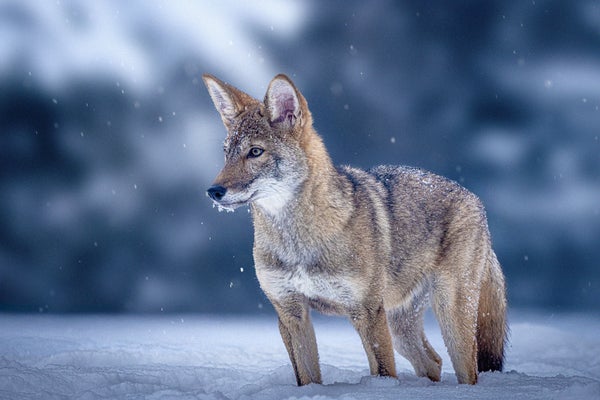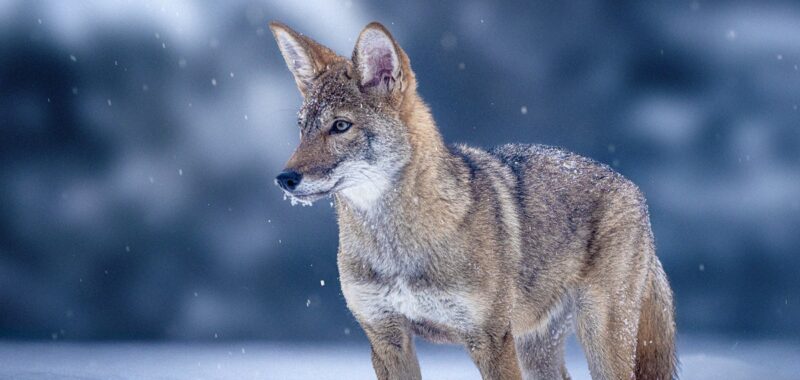The Dire Wolf Hoopla Hides the Real Story: How to Save Red Wolves
Rather than resurrect extinct species, cloning technology could save those at risk of dying out, like the red wolf, but only with solid conservation efforts and habitat protections

Colossal Biosciences has cloned four red wolf pups from living red wolves. The technology could aid conservation efforts in saving the species.
Four cloned red wolves that fell out of the spotlight—hidden amid “de-extinction” hoopla about vanished dire wolves—tell the real secret to saving threatened species. And the answer isn’t a magical cloning technology.
This month Colossal Laboratories & Biosciences announced the birth late last year of three gray wolf puppies with 15 gene variants that belonged to dire wolves (Aenocyon dirus); this large carnivore went extinct about 13,000 years ago. Colossal, based in Dallas, touted the (adorable, white) genetically engineered pups as a step toward “Making Extinction a Thing of the Past” on its website. There was pushback. “This is a designer dog. This is a genetically modified gray wolf,” Jacquelyn Gill, a paleoecologist at the University of Maine, told Scientific American. Colossal’s chief science officer Beth Shapiro, also an evolutionary biologist, later called such criticism “fair points” on X but defended the “de-extinction” claim. The company’s dire wolf claims were released earlier than a peer-reviewed study describing them was published (because the New Yorker released results ahead of schedule, according to Shapiro), which also has added to scientific skepticism.
Colossal simultaneously announced it had cloned four red wolf pups from three living adult red wolves. Red wolves (Canis rufus) once spread from Texas to the Carolinas, but the species was declared extinct in the wild in 1980. Fewer than 20 remain alive today in captivity, all tracing their genes to just 12 founding wolves. “Adding Colossal’s red wolves to the captive breeding population would increase the number of founding lineages by 25 [percent],” the company said in promotional material.
On supporting science journalism
If you’re enjoying this article, consider supporting our award-winning journalism by subscribing. By purchasing a subscription you are helping to ensure the future of impactful stories about the discoveries and ideas shaping our world today.
That’s swell. But history shows there is a lot more than genetics needed to save red wolves. Red wolf numbers plummeted in the 1970s, because of lost habitat and hunting, as well as inbreeding with coyotes. More than fresh genes, red wolves need habitat and careful conservation, or else they’ll die off again. We know because we tried before.
Starting in 1973 a U.S. Fish and Wildlife Services captive-breeding program built up their population to more than 120 red wolves, and later tried to re-introduce them into the wild in North Carolina. But when that program ended during the first Trump administration, their numbers plummeted to only seven wolves. People driving to and from the Outer Banks on I-64 kept killing the wolves, while hunters shot them as coyotes. The FWS program was restarted in 2021, but now only has about 20 wolves. (On top of everything else, the Trump administration in February fired about 5 percent of the agency’s workforce.) Red wolves face some big challenges.
“I think that gene modification is a reasonable subject of basic scientific investigation that could someday offer assistance to red wolf (and other) conservation,” says Benjamin Sacks of the University of California, Davis, an expert on red wolf genetics. “But [it] is not likely to be a particularly useful tool for red wolf conservation at present.”
Colossal’s four red wolves derive their genetics from cloning-amenable blood cells that serve as the “progenitors” to blood vessel linings, called endothelial progenitor cells. Along Louisiana’s Gulf Coast, researchers collected these progenitor cells from blood samples of “ghost wolves,” coyotes with large amounts of red wolf ancestry. In a genuine scientific feat, Shapiro and her team placed the central nucleus of some of these progenitor cells inside donor dog eggs in a process called stem cell nuclear transfer; then they implanted the fertilized egg into a surrogate dog mother that gave birth to the pups, which were clones of the blood-drawn ghost wolves.
“By cloning the red wolves from Louisiana while also leaving these individuals in the wild, their DNA both persists in the wild population and is brought into a research setting where they have the potential to contribute new red wolf ancestry to the captive population,” Shapiro tells Scientific American by e-mail. Colossal is currently working with wildlife agencies, she adds, “to find a path that allows this.”
All of that seems a little elaborate, compared with just breeding the Louisiana wolves with the FWS program wolves the old-fashioned way, and then letting them go free afterward. “We have little or no idea what unseen effects the cloning process has on offspring and future generations, so why risk it unnecessarily?” says Sacks.
More fundamentally, scientists currently don’t even have a good picture of red wolf genetics. While they estimate that 80 percent of ghost wolf genes are from red wolf ancestors, and not coyotes, they don’t know for sure which ones are which. Canada’s so-called “eastern” wolves might be a closer match to red wolves for example, and thus better sources of genetic diversity for their revival, again through old-fashioned breeding.
The danger of thinking that genetic technology can replace the hard work of conserving habitat and rebuilding healthy populations of threatened animals soon became clear with the dire wolf news, when the new U.S. Department of Interior secretary, Doug Burgum, who oversees the FWS, pointed to the genetically engineered “dire wolf” pups to undermine the Endangered Species Act. “If we’re going to be in anguish about losing a species, now we have an opportunity to bring them back,” he told Interior Department employees, according to the Washington Post. “Pick your favorite species and call up Colossal.”
Sure. Let’s kill off every endangered creature. Billionaire businessmen like Burgum will just order up a new one from the gene factory for their private amusement. Shades of Jurassic Park. In the meantime, his boss just signed an executive order calling for “increased timber production” on the federal lands that once housed this vanished wildlife. What a wonderful future. Colossal did itself no favors by touting Burgum’s endorsement on its website.
“One of my concerns about all the hype about ‘de-extinction’ is the drive to hurry into the spotlight before enough is understood, which risks making Colossal mistakes, and to distract attention and funding from the more pressing priorities,” says Sacks, by e-mail. “I also get nervous because the science is being done behind closed doors for profit.”
This is an opinion and analysis article, and the views expressed by the author or authors are not necessarily those of Scientific American.

